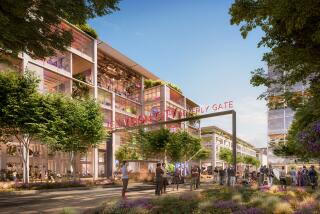CRA Plans in Northeast Valley May Move Ahead
- Share via
PACOIMA — Plans for a massive redevelopment project to attack blight in the northeast San Fernando Valley got back on track Monday with the reorganization of a citizens advisory committee.
Meeting for the first time since a contentious December election, committee members filled three vacancies on the 23-member committee, then elected a four-member executive committee to guide the group’s work.
The committee had been derailed since September, when membership had dwindled to five. More than 40 candidates competed in the subsequent election to fill 18 seats, leaving three of the seats undecided because of multiple tie votes.
Several committee members had earlier suggested that the redevelopment proposal be dropped because it appeared to have little backing from the community. However, Los Angeles City Councilman Alex Padilla, who represents the northeast Valley, urged that the committee be reactivated.
“Sometimes we need a hammer,” Padilla said at Monday’s meeting. “We need positive change in the northeast Valley. We need the tools. Sometimes we need the hammer to drive the right nail into the stud.”
Redevelopment critics complained that Padilla engineered an outpouring of pro-redevelopment voters, but the councilman said that he was simply trying to promote public participation.
Two years ago, the Community Redevelopment Agency proposed formation of the city’s largest redevelopment project area, covering 6,835 acres. The plan calls for spending about $490 million over the next four decades to spur development in an area that includes parts of Sylmar, Pacoima, Arleta, Sunland-Tujunga, Lake View Terrace, Sun Valley, North Hollywood, Mission Hills, Panorama City, Reseda and Van Nuys.
Under state law, a Project Area Committee consisting of residents, business owners and others with a stake in the community can recommend specific areas of blight and the proposed scope of a redevelopment project. The committee, however, serves only as an advisory board, with the ultimate power lying with the CRA Board of Directors and the Los Angeles City Council.
The committee consists of factions both for and against redevelopment, but the December election resulted in a majority of seats going to pro-redevelopment advocates. However, even some of those who won election and support redevelopment said the plan needs to be scaled back.
Elected Monday to fill the three contested seats on the committee were Joe Lopez, representing Harrison Sports of Pacoima; Tracy Lovejoy of Waste Management of Sun Valley; and Caron Caines, an attorney with San Fernando Valley Neighborhood Legal Services.
Elected to the executive committee were Caines, Carol Silver of the Sun Valley Chamber of Commerce, business owner Arthur Sweet and homeowner Yolanda Fuentes.
Padilla called economic redevelopment in the northeast Valley “my highest priority. From Sylmar to Sun Valley to Pacoima, there is a critical need for improved housing, more businesses, and new jobs.”
He said that with the action Monday, the committee “can now officially begin to move forward with recommendations for redevelopment.”
When a redevelopment zone is formed, property values are frozen. Government subsidies and other incentives are used to spur new development, replacing blighted areas with new housing, office buildings and business projects. As property values rise with new development, the incremental increases in tax revenues are earmarked specifically for use in the redevelopment zone and used to encourage still more development.
The incremental funds continue to build throughout the life of the zone, such as the 40 years proposed in the northeast project. State rules restrict the use of portions of the fund, such as the 20% which must be set aside for housing.
Opponents argue that such projects--there are 31 in Los Angeles--divert tax revenues that could otherwise be used for police, firefighting, schools and other services. Proponents say that without the funds, blighted areas will continue to deteriorate.
More to Read
Sign up for Essential California
The most important California stories and recommendations in your inbox every morning.
You may occasionally receive promotional content from the Los Angeles Times.










